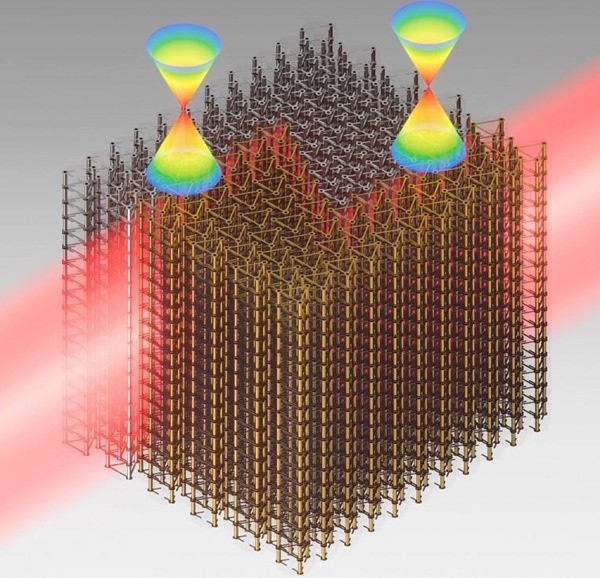
Fig. Dirac-like surface states propagate through the sharp bents
Supported by the National Natural Science Foundation of China (No. 61625502, 61574127), Hongsheng Chen’s group at Zhejiang University in China and their coworkers, Baile Zhang and Yidong Chong at Nanyang Technological University in Singapore have now announced the realization of three-dimensional (3D) photonic topological insulator, expanding the concept of 3D topological insulator from fermions to bosons system. The relevant work is published in the journal of Nature on January 9th 2019 entitled “Realization of a three-dimensional photonic topological insulator”. (link: http://www.nature.com/articles/s41586-018-0829-0).
Topological insulators are one of the research hotspots in condensed matter physics, and the Nobel physical prize in 2016 has rewarded the research on topological phase, which may be significant for quantum computing and low-power electronic devices. Light propagating in the waveguide or medium interface will suffer inevitable scattering when encounters defects, impurities, corners etc., which results in energy loss and a great decrease of the transmission efficiency. The properties of topological insulator materials lie between conductors and insulators, which behave as an insulator in the interior and a conductor on the surface of material. The surface current originates from the topological characteristics of the electronic energy band and can be immune to defects, corners and disorder, which realizes efficient transport of electrons. However, the experimental study of optical topological insulators is limited to two-dimensional space.
Prof. Hongsheng Chen’s group and their coworkers have designed a multiple split-ring resonators structure and experimentally realized a 3D photonic topological insulator with full bandgap. Using direct near-field imaging measurements, they map out both the gapped bulk band structure and the Dirac-like dispersion of the surface states (seen in Figure). Due to the surface photon protection by the topology, the structure could construct the photonic “high way”, which protects the photons against defects. This work may extend to the experimental realization of 3D topological insulator in other bosonic systems, such as phonon and cold-atom systems. It is of great significance to expand the 3D topological system.

Add: 83 Shuangqing Rd., Haidian District, Beijing, China
Postcode: 100085
Tel: 86-10-62327001
Fax: 86-10-62327004
E-mail: bic@donnasnhdiary.org
京ICP备05002826号 文保网安备1101080035号 Copyright 2017 NSFC, All Right Reserved